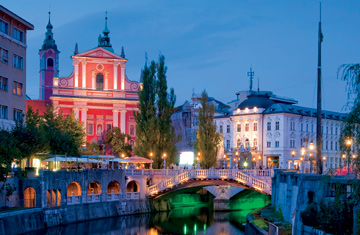
Tiny gem The Old Town's beauty and compact dimensions make it a strollers' delight
Slovenia's under-the-radar capital, Ljubljana, doesn't lack architectural beauty — its Baroque churches and cobblestoned streets hold their own against the likes of storybook Prague or Vienna. Nor does it want for sophisticated cuisine or culture, with a lively restaurant scene, cutting-edge galleries and underground bars and clubs reminiscent of those of a much bigger city. What Ljubljana doesn't have yet — remarkably — are the hordes of tourists that trample Europe's other capitals every summer. It feels like Central Europe's best-kept secret.
Ljubljana has one man to thank for its genteel air: Joze Plecnik, Slovenia's most celebrated architect and urban planner. Plecnik redesigned the medieval Old Town in the 1920s and 1930s, widening streets, laying out plazas and building such unique structures as the Triple Bridge (its three intertwining spans cross the Ljubljanica River) and the National and University Library, built from 1936 to 1941 and combining both classical and contemporary elements in a kind of early postmodernism. Spotting Plecnik's designs on a stroll (or bike ride) through the Old Town is an immensely pleasurable way to get oriented with the compact city center.
Be sure to refuel frequently at a riverfront café or, for something more substantial, try one of the Old Town's atmospheric restaurants. At Spajza, tel: (386-1) 425 3094, the specialty is traditional Slovenian cooking, with dishes like goat-cheese-filled buckwheat crepes and — a favorite in this part of the world — horse fillet coated with a generous helping of Istrian truffles. The Old World homeliness is reinforced by the setting: a 19th century house with creaking wooden floors and a romantic garden with candlelit tables.
Not that Slovenia is mired in the past. Since independence in 1991, a fresh generation of artists and designers has been eagerly putting its own creative stamp on the country's rich culture. The hub of this new activity is Metelkova Mesto, metelkova.org, a former Yugoslav army barracks that was taken over by squatters in the early 1990s and has since been revitalized as an arts district with graffiti- and mosaic-covered galleries, live-music venues and nightclubs packed out with tattooed young Slovenes. From 2011, it will also be home to a new Contemporary Art Museum (a spin-off of the Museum of Modern Art, mg-lj.si) displaying Eastern European work. "Ljubljana is unique in that the major institutions are deeply involved in the grass-roots art scene," says Zdenka Badovinac, director of the Museum of Modern Art. "We're all working in a collective spirit — it's one of the positive legacies of socialism."
Even the old jail at the barracks has been reborn as an imaginative hostel, the Celica, souhostel.com. Following independence, a team of artists was commissioned to turn 20 of the once dreary cells, where political prisoners (including a future Slovene Prime Minister) had been locked up in communist times, into individually designed guestrooms. While the original bars still hang on the doors and windows, new murals, modern glass and hardwood floors and built-in bed platforms keep a stay there from feeling too much like, well, a prison sentence. For something more upscale, try the 200-room City Hotel, cityhotel.si, a recently renovated, early 20th century building with brightly painted rooms and free wi-fi.
The must-have souvenir for any visitor, a plump sack of salt, may seem unusual at first. But it's gourmet sea salt, sourced from salt pans on Slovenia's tiny strip of Adriatic coastline, where it's still hand-produced using medieval techniques. A good place to pick some up is Piranske Soline, soline.si, a specialist boutique in the Old Town. Of course, in a country this minuscule — Slovenia is slightly smaller than New Jersey — the Secovlje salt pans, kpss.si, and the sparkling Adriatic are also an easy day trip from Ljubljana. But the city's laid-back charms may convince you to instead stay put and sip one more macchiato on the banks of the lazy Ljubljanica, reveling in the lack of tour buses while you still can.
Got an awful travel gripe? The Avenger may be able to sort it out for you.
